It’s that time again: a weeknight when you need a quick, easy, nutritious dinner on the table and it needs to be there ASAP. You’re racking your brain about what kind of meatless meal is going to feed your hungry family.
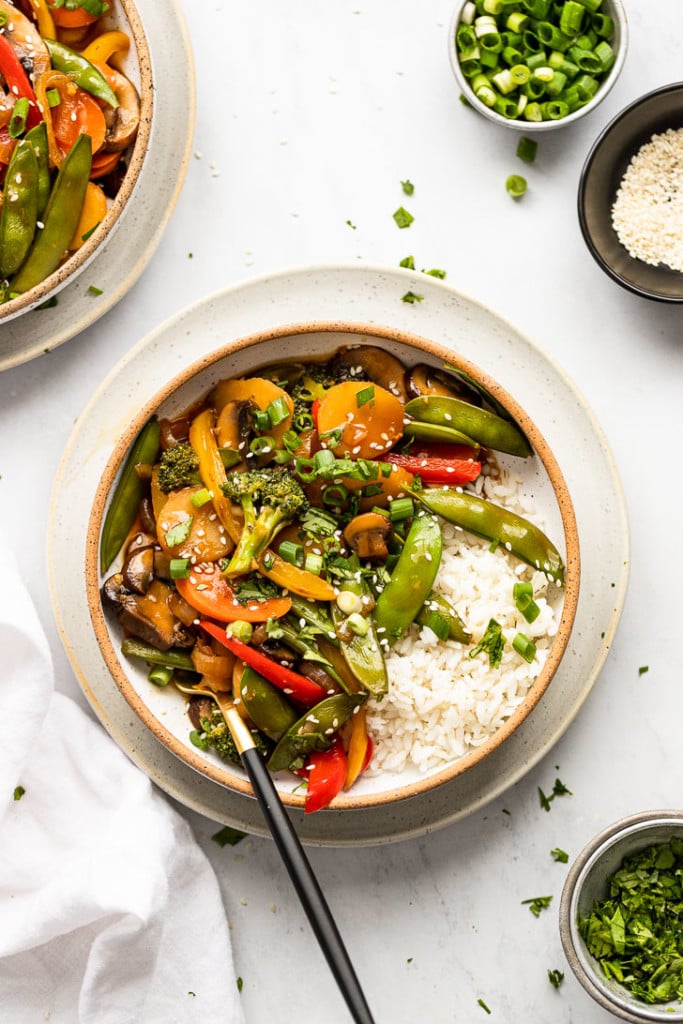
And then it comes to you… Vegetable Stir Fry to the rescue.
In less than 5 minutes you can whip up the stir fry sauce, then all you need to do is prep a couple of vegetables (or use what you already have in your fridge), and it comes together in a snap. I’d call that a dinner win.
What is stir fry?
Similar to sauteing, stir-frying is a Chinese method of cooking where the ingredients – in this case, vegetables – are cooked in a wok over high heat, quickly cooking them.
Stir fry uses a minimal amount of oil, so a lot of people consider it a healthy option, and a delicious way to enjoy vegetables and proteins. Because the vegetables are also cooked so quickly, they retain many of their nutrients in the cooking process, as long as you don’t overcook them!
According to Wikipedia, there are various stir-fry techniques. While this recipe is very much only inspired by traditional Chinese stir fry recipes and is definitely along the lines of the American-Chinese dishes I’ve had here, it is similar to the Chao technique mentioned in the article, where the vegetables are cooked with sauce ingredients towards the end.
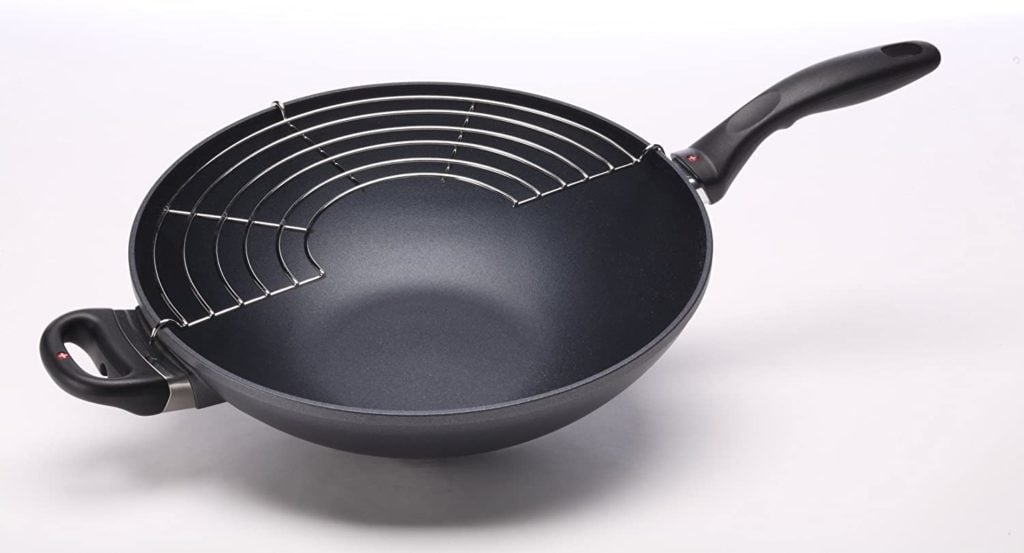
12.5″ Wok
If you love to make stir-fry for dinner, I highly recommend this wok. It’s the perfect size, large enough to hold all your veggies and noodles while cooking them evenly.
Vegetable Stir Fry Ingredients
This is worth repeating several times throughout this post: the veggies listed are simply a guideline and you can absolutely mix and match depending on your preferences and what you have on hand.
The beauty of making a veggie stir fry is how versatile it is. And isn’t that the beauty of homemade stir fry? Whether it’s mixed veggie, bok choy, or noodle stir fry, you can’t go wrong.
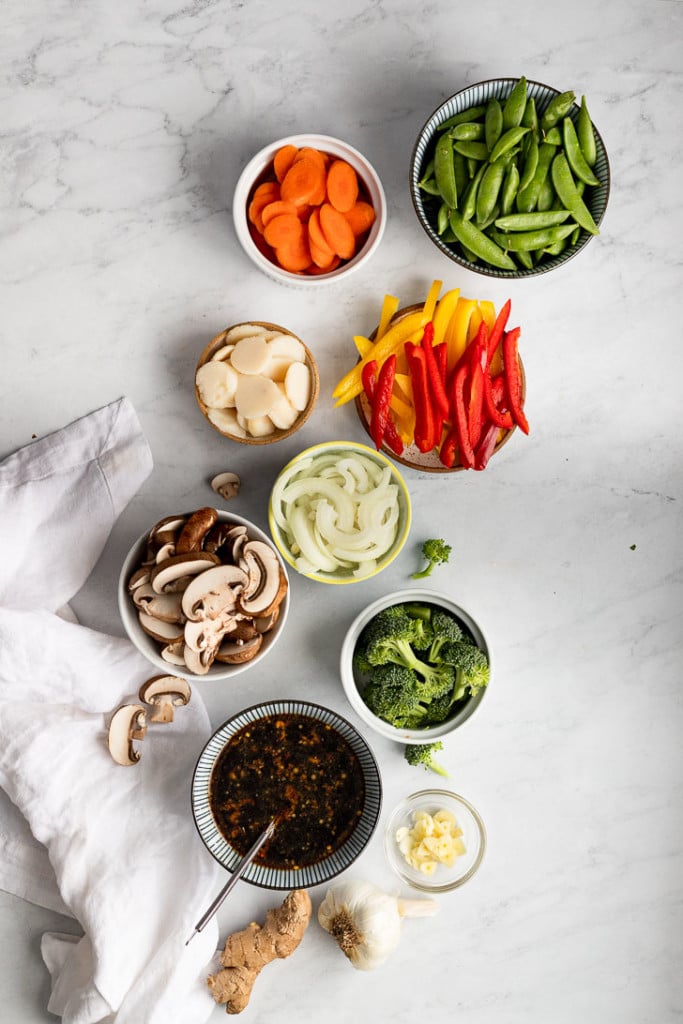
I’ll make some notes below about the order of adding ingredients for when you do make substitutions because we don’t want to overcook them. Now, here’s what you’ll need (or again, along the lines…):
- Yellow Onion: with its sweet, mild flavor, it’s a wonderful addition to stir fry. If you like a more sharp onion flavor, you could use a white onion in its place.
- Mushrooms: a hearty, meaty addition to a veggie stir fry. They are added first in the cooking process so they can release all their liquid before the other ingredients are added.
- Sugar Snap Peas (or snow peas): either one will work. Keep in mind that snap peas have a thicker exterior and will take longer to cook. If using snow peas, with their flat, thin walls, add them towards the end of the cooking process so they don’t overcook.
- Carrot: cut whole carrots on the bias in slices for an interesting texture. However, you can really make them whatever shape you want (see the tips and tricks for sizing).
- Broccoli: adding broccoli florets is a must IMO, they’re hearty and colorful and add a wonderful texture to the stir fry.
- Red or Yellow Bell Pepper: pictured here, I used half of each type of bell pepper for more color. You can use orange, too, there’s no wrong way to bell pepper this recipe.
- Water Chestnuts: a must-have in stir fry here, water chestnuts are not actually nuts, but a tuber vegetable that grows in water. You’ll typically find them in a can here in the US. They don’t have much flavor at all, which means they’re perfect for pairing with a stir-fry sauce. Their texture is crisp and kind of juicy, adding a wonderful contrast to the dish.
- Garlic: of course, I’m adding garlic! If you’re wondering what to add to stir fry for more flavor… it’s the aromatics! Garlic and…
- Ginger: yep, adding a little more ginger even though it’s in the sauce. You can use fresh ginger (for the brightest flavor), or jarred/canned minced ginger will work, too.
- Stir Fry Sauce: trust me, you want to make homemade sauce. It takes less than 5 minutes and is oh-so-delicious!
- I like it saucy, so I add the entire 1 1/4 cups, but if you prefer less saucy stir fry, start with about 1 cup of sauce and add more as desired. Save the rest in the fridge or freezer for next time!
How to Make Veggie Stir Fry
Alright, my friends, this is an easy quick recipe that will come together quickly! The key is to not overcook the vegetables so they remain tender-crisp. No soggy veggies allowed. This means that while this vegetable stir fry recipe is easy, there is an order to follow.
What vegetables do you stir fry first?
When making stir fry, you want to start cooking the vegetables that will take the longest to cook.
This way, by the time the recipe is finished, they will be ready and the quick-to-cook veggies will be perfectly done (rather than overcooking if added too soon).
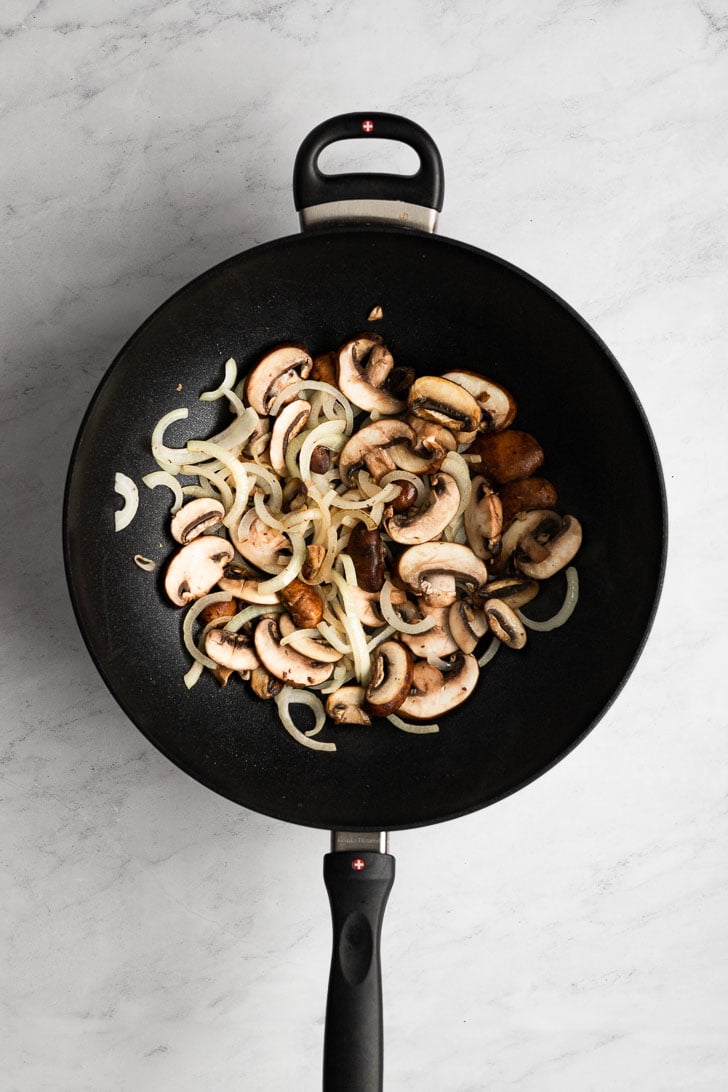
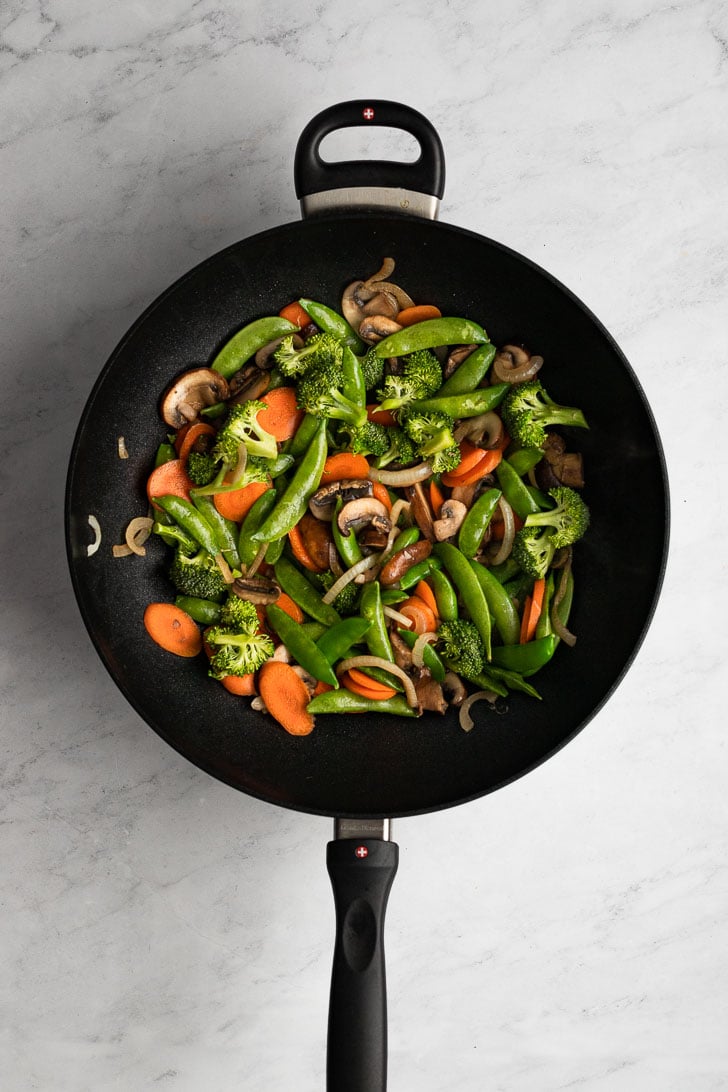
With my ingredients listed, that means we are starting with the onion and mushrooms. The onion, because while it will be tender rather quickly, it is delicious when caramelized, which happens with a longer cooking time.
It’s important to add the mushrooms first, too, because they take longer to release their liquid. Adding them too late results in a watery stir fry — no good.
After they have a headstart, add the remaining ‘hearty’ vegetables: carrots, broccoli, and sugar snap peas (if using snow peas – wait!).
The quick-to-cook veggies
Once they have softened slightly, it’s time to add the rest of the quicker-to-cook veggies. Again, we don’t want to overcook any of our vegetables!
Add bell pepper, water chestnuts, garlic, and ginger. Stir fry them for a minute, then add in the sauce, stirring to coat.
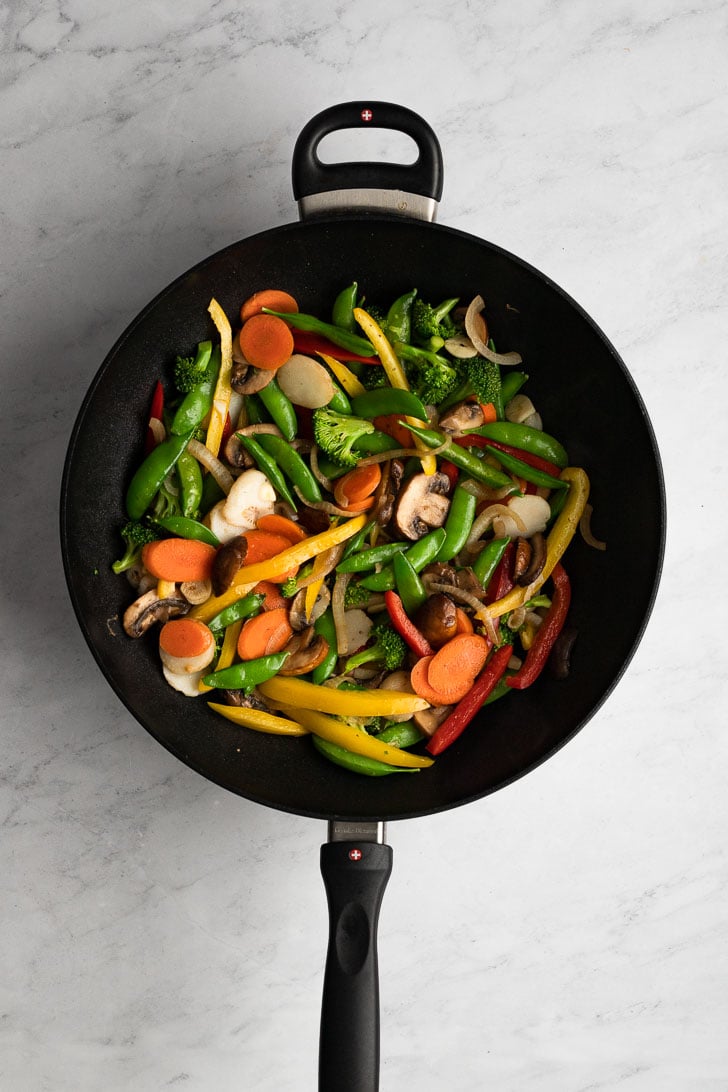
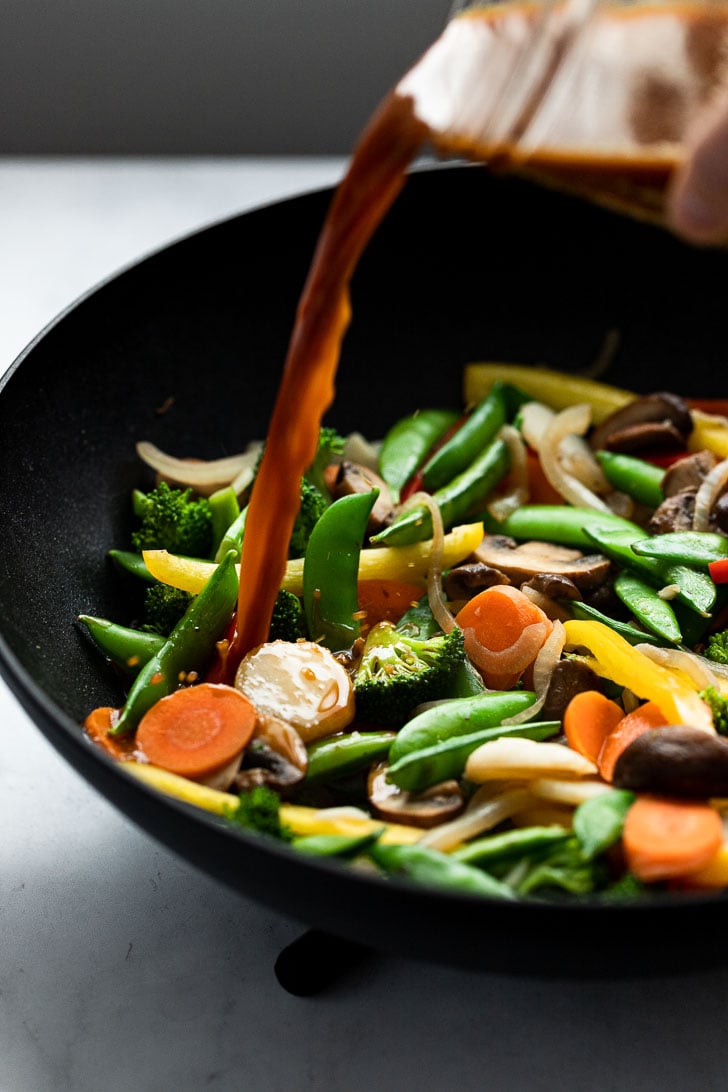
Everything will cook with the sauce for a few minutes so it can thicken up (thanks to the cornstarch), so keep in mind that we don’t want the veggies to be done when we add the sauce, we only want them par-cooked, so they finish with the sauce.
As noted above, only add 1 cup of the sauce to start if you like a less saucy stir fry, adding more as desired.
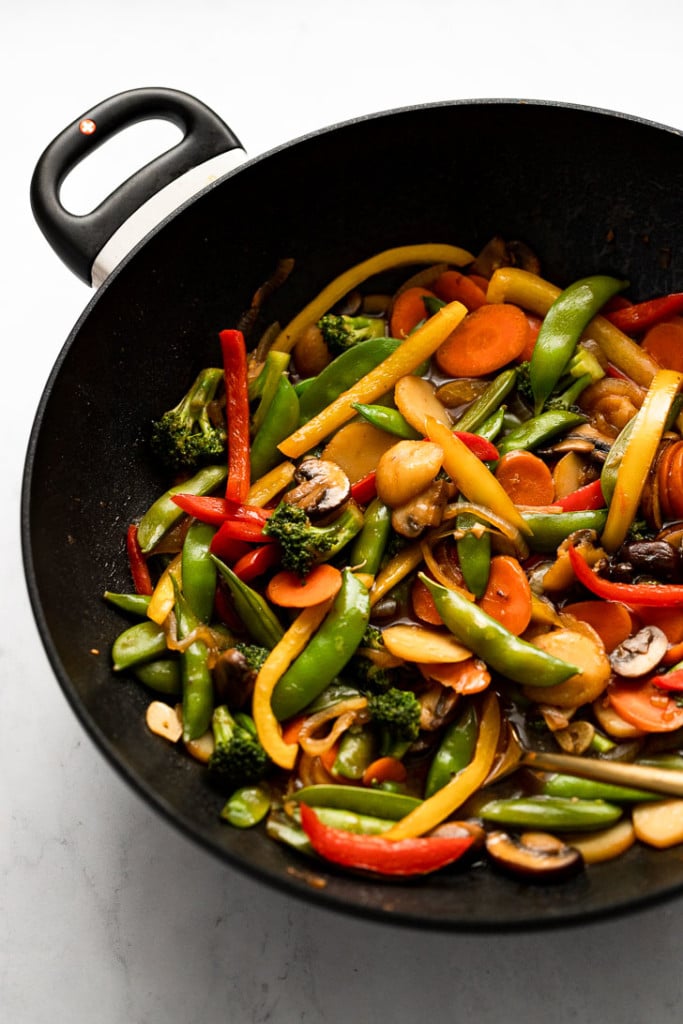
What to Serve with Vegetable Stir Fry
My favorite go-to for this veggie stir fry is simply to serve it with rice (or hey, cilantro lime rice!). It sops up the extra sauce, adds texture, and is just simply the best.
Fluffy white rice is my favorite, but you can also use brown rice or another grain like quinoa if you want to add more fiber to the meal.
Another option is to serve it over rice noodles (or just go ahead and make my noodle stir fry in this case).
You can also serve it with a side of salmon or shrimp (if you eat seafood), or even chicken or beef if you are a meat eater. Crispy tofu would be a delicious side as well.
Because it has an abundance of veggies, I don’t necessarily think a vegetable side would add much to the dish. It’s hearty enough on its own. But if you do want another lighter vegetable, I would suggest something like a bok choy side dish.
Adding Garnishes
I love to garnish stir fry with slices of green onion (both the white and green parts), cilantro, sesame seeds, and sometimes even a squeeze of fresh lime juice. Bean sprouts would be a texture-filled addition if you have them, or some chopped cashews or peanuts, too.
Play around with your favorite flavors and textures for garnish, and be sure to let me know what you try below in the comments!
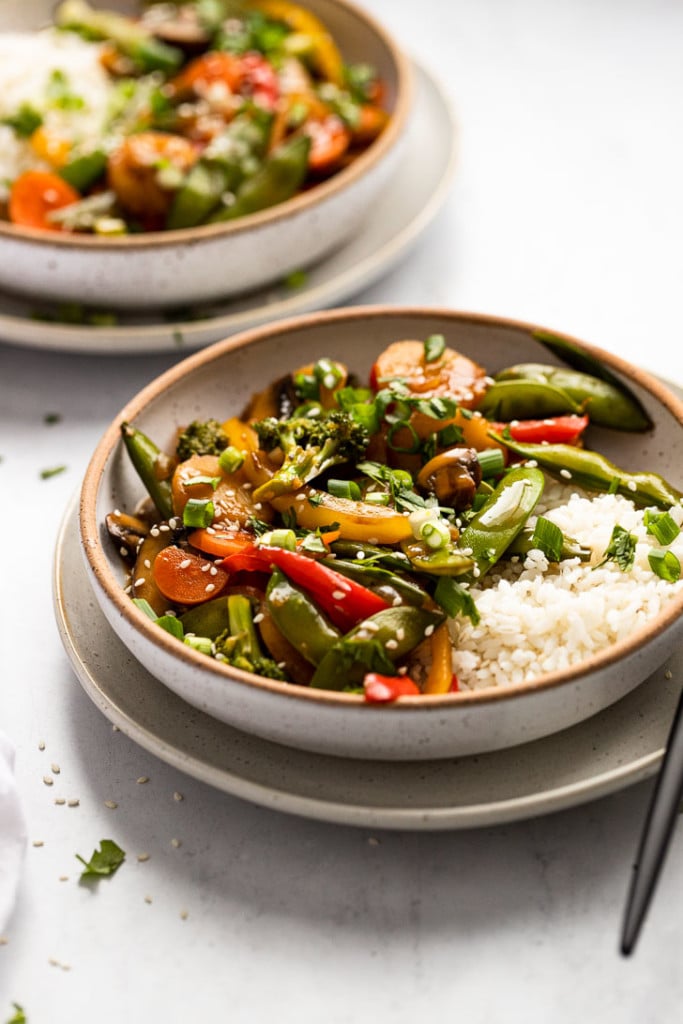
Tips for Recipe Success
Here are a few important key tips for making the best veggie stir fry.
- Cut the vegetables into evenly sized pieces. This ensures even cooking and makes eating easier.
- Prep the veggies in advance. Make sure the veggies are prepped before you start cooking – because it will go quickly once you start. This also means you should make the sauce ahead of time, too. With everything ready, the recipe is quick, quick, quick!
- Use a large pan or wok. This gives the veggies room to cook evenly and allows for proper caramelization. If your pan is too small, they’ll steam instead.
- Find canned water chestnuts in the ‘Asian food’ aisle of your local grocery store. You can also find canned baby corn there too, which is a fun addition.
Make-Ahead and Freezing Tips
To make this recipe ahead of time, I recommend prepping the ingredients and sauce, then storing them – separately – in the fridge until you’re ready to make the stir fry. This makes weeknight dinners extra quick and makes meal prep easy.
If you want to freeze, or store leftovers, I recommend placing the stir fry in Souper Cubes, then top it with extra rice. This makes an easy go-to for lunch or dinner. Otherwise, you can freeze the stir fry by itself.
Reheat in the microwave on the defrost setting until heated through, or on the stovetop over low-medium heat.
To store leftovers in the fridge, simply place them in an airtight container in the fridge for up to 4 days. Reheat in the microwave or on the stove until heated through.
Frequently Asked Questions
Yes, you can! There is even a ‘stir fry vegetable’ frozen mix that I’ve seen at many grocery stores. Simply make the sauce, then cook the frozen vegetables to the hot pan for just a minute. Add the sauce, simmer until thick, and the veggies are heated through.
Yes! Just use sugar in place of the honey in the sauce, and this recipe is vegan. Otherwise, it’s considered a vegetarian recipe without any meat or fish products.
As long as you use a gluten-free soy sauce, like Tamari, and check the ingredients listed on the other products, you can make this recipe gluten-free.
Did you make this recipe? Please leave a star rating and review in the form below. I appreciate your feedback, and it helps others, too!
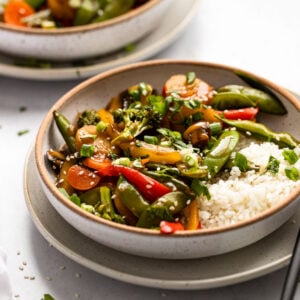
Get the Recipe 25-Minute Mixed Vegetable Stir Fry
Ingredients
Stir Fry Sauce
- ½ cup soy sauce, low sodium recommended
- ½ cup vegetable stock*, or water
- 1 teaspoon sesame oil
- 1/2 tablespoon rice vinegar
- 2 cloves garlic, minced
- 1-2 teaspoons ginger, grated or minced
- 1 tablespoon sugar or honey, more for a sweeter sauce
- 1 tablespoon cornstarch
- Pinch red pepper flakes, optional
Stir Fry Vegetables
- 1 Tablespoon neutral oil
- ½ cup yellow onion, thinly sliced
- 8 ounces mushrooms, sliced
- ½ cup carrots, sliced on the bias (diagonal)
- 8 ounces snow or snap peas
- 1 cup broccoli florets, bite-sized pieces
- 1 red or yellow bell pepper, thinly sliced
- 8 ounces canned water chestnuts, sliced, drained*
- 2 cloves garlic, thinly sliced or minced
- 1 teaspoon ginger, finely chopped or minced
Equipment
Instructions
- The Sauce: whisk together the stir fry sauce ingredients and set aside.½ cup soy sauce, ½ cup vegetable stock*, 1 teaspoon sesame oil, 1/2 tablespoon rice vinegar, 2 cloves garlic, 1-2 teaspoons ginger, 1 tablespoon sugar or honey, 1 tablespoon cornstarch, Pinch red pepper flakes
- In a wok or large saute pan, heat oil over medium-high heat. Add the sliced onion and mushrooms, let cook for 2-3 minutes.1 Tablespoon neutral oil, ½ cup yellow onion, 8 ounces mushrooms
- Add carrots, sugar snap peas (wait if using snow peas), and broccoli. Cook for 2 minutes.8 ounces snow or snap peas, ½ cup carrots, 1 cup broccoli florets
- Add bell pepper, water chestnuts, garlic, and ginger (snow peas here, if using instead of snap peas). Cook for 1-2 minutes, then stir in the sauce and allow it to simmer until thick and the vegetables are tender, about 2-3 minutes.1 red or yellow bell pepper, 8 ounces canned water chestnuts, sliced, 2 cloves garlic, 1 teaspoon ginger
- Serve over rice or noodles. Garnish with green onions, cilantro, bean sprouts, a squeeze of lime, or sesame seeds as desired.
Notes
- Water Chestnuts: buy them sliced, and chop if you’d like them in smaller pieces.
- Storage: place leftovers in an airtight container in the fridge for up to 4 days or freeze in a freezer-safe container for up to 2 months.
- Sauce: the sauce makes approximately 1 1/4 cups; if you prefer a less saucy stir fry, add about 1 cup of the sauce and continue adding more until the desired amount is reached.
- To make the sauce even thicker, add an additional 1/2 tablespoon of cornstarch.
- Use stock with no added salt.
- See the stir fry sauce post for additional recipe tips.

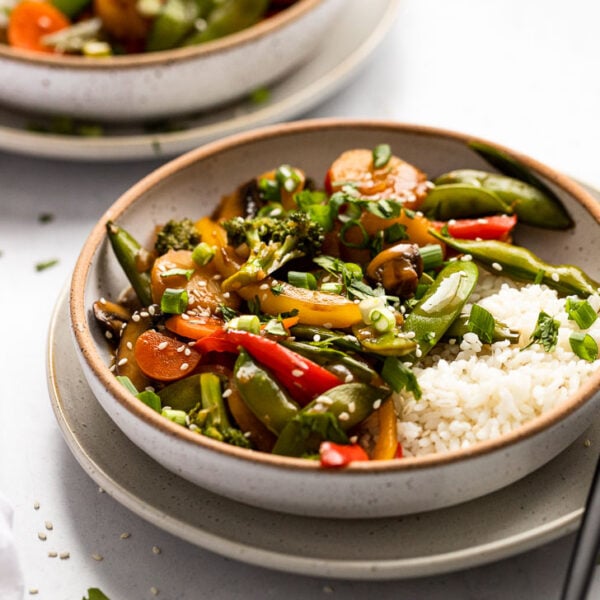


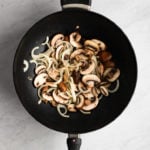
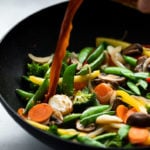



Delicious!!!
So glad to hear you enjoyed, Mia!
I reduced soy sauce to 1/3 cup and it was still a bit too salty for us. I will try low-sodium soy sauce next time. Otherwise, it was delicious and fun to make. Thanks for the recipe!
Thanks for the feedback, Sue! I recommend low-sodium in the sauce post but hadn’t mentioned it on this post (oops!) so I have updated it now. Thanks again, I’m glad you had fun making it! 🙂
Delicious recipe enjoyed by the whole family. The sauce is perfect. Quick and easy to make.
I’m so glad to hear! Thanks for sharing, Ginny!
It’s so delicious and I wouldn’t change a thing!
I’m so glad you enjoy it! Thanks so much for your review, Eileen!